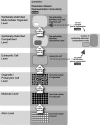Levels and building blocks-toward a domain granularity framework for the life sciences
- PMID: 30691505
- PMCID: PMC6348634
- DOI: 10.1186/s13326-019-0196-2
Levels and building blocks-toward a domain granularity framework for the life sciences
Abstract
Background: With the emergence of high-throughput technologies, Big Data and eScience, the use of online data repositories and the establishment of new data standards that require data to be computer-parsable become increasingly important. As a consequence, there is an increasing need for an integrated system of hierarchies of levels of different types of material entities that helps with organizing, structuring and integrating data from disparate sources to facilitate data exploration, data comparison and analysis. Theories of granularity provide such integrated systems.
Results: On the basis of formal approaches to theories of granularity authored by information scientists and ontology researchers, I discuss the shortcomings of some applications of the concept of levels and argue that the general theory of granularity proposed by Keet circumvents these problems. I introduce the concept of building blocks, which gives rise to a hierarchy of levels that can be formally characterized by Keet's theory. This hierarchy functions as an organizational backbone for integrating various other hierarchies that I briefly discuss, resulting in a domain granularity framework for the life sciences. I also discuss the consequences of this granularity framework for the structure of the top-level category of 'material entity' in Basic Formal Ontology.
Conclusions: The domain granularity framework suggested here is meant to provide the basis on which a more comprehensive information framework for the life sciences can be developed, which would provide the much needed conceptual framework for representing domains that cover multiple granularity levels. This framework can be used for intuitively structuring data in the life sciences, facilitating data exploration, and it can be employed for reasoning over different granularity levels across different hierarchies. It would provide a methodological basis for establishing comparability between data sets and for quantitatively measuring their degree of semantic similarity.
Keywords: Building block; Domain granularity framework; Granularity; Hierarchy; Knowledge management; Level; Ontology; SEMANTICS.
Conflict of interest statement
Ethics approval and consent to participate
Not applicable.
Consent for publication
Not applicable.
Competing interests
The author declares that he has no competing interests.
Publisher’s Note
Springer Nature remains neutral with regard to jurisdictional claims in published maps and institutional affiliations.
Figures









Similar articles
-
Spatio-structural granularity of biological material entities.BMC Bioinformatics. 2010 May 28;11:289. doi: 10.1186/1471-2105-11-289. BMC Bioinformatics. 2010. PMID: 20509878 Free PMC article.
-
Anatomy and the type concept in biology show that ontologies must be adapted to the diagnostic needs of research.J Biomed Semantics. 2022 Jun 27;13(1):18. doi: 10.1186/s13326-022-00268-2. J Biomed Semantics. 2022. PMID: 35761389 Free PMC article.
-
Semantic Technologies and Bio-Ontologies.Methods Mol Biol. 2017;1617:83-91. doi: 10.1007/978-1-4939-7046-9_6. Methods Mol Biol. 2017. PMID: 28540678
-
Semantic Web technologies for the big data in life sciences.Biosci Trends. 2014 Aug;8(4):192-201. doi: 10.5582/bst.2014.01048. Biosci Trends. 2014. PMID: 25224624 Review.
-
The need for data standards in zoomorphology.J Morphol. 2013 Jul;274(7):793-808. doi: 10.1002/jmor.20138. Epub 2013 Mar 18. J Morphol. 2013. PMID: 23508988 Review.
Cited by
-
The Complexity of Reasoning about and with Chemical Representations.JACS Au. 2022 Nov 9;2(12):2658-2669. doi: 10.1021/jacsau.2c00498. eCollection 2022 Dec 26. JACS Au. 2022. PMID: 36590267 Free PMC article. Review.
-
Establishing neuroanatomical correspondences across mouse and marmoset brain structures.Res Sq [Preprint]. 2024 May 21:rs.3.rs-4373678. doi: 10.21203/rs.3.rs-4373678/v1. Res Sq. 2024. PMID: 38826382 Free PMC article. Preprint.
-
The use of foundational ontologies in biomedical research.J Biomed Semantics. 2023 Dec 11;14(1):21. doi: 10.1186/s13326-023-00300-z. J Biomed Semantics. 2023. PMID: 38082345 Free PMC article. Review.
-
FAIR data representation in times of eScience: a comparison of instance-based and class-based semantic representations of empirical data using phenotype descriptions as example.J Biomed Semantics. 2021 Nov 25;12(1):20. doi: 10.1186/s13326-021-00254-0. J Biomed Semantics. 2021. PMID: 34823588 Free PMC article.
-
Transforming the study of organisms: Phenomic data models and knowledge bases.PLoS Comput Biol. 2020 Nov 24;16(11):e1008376. doi: 10.1371/journal.pcbi.1008376. eCollection 2020 Nov. PLoS Comput Biol. 2020. PMID: 33232313 Free PMC article. Review.
References
-
- Wilson D. Forms of hierarchy: a selected bibliography. In: Whyte LL, Wilson AG, Wilson D, editors. Hierarchical structures. New York: American Elsevier; 1969. pp. 287–314.
-
- Woodger JH. Biological principles: a criticial study. London: K. Paul, Trench, Trubner and Co.; 1929.
-
- Wimsatt WC. Reductionism, levels of organization, and the mind–body problem. In: Globus G, Maxwell G, Savodnik I, editors. Consciousness and the brain: a scientific and philosophical inquiry. New York: Plenum Press; 1976. pp. 199–267.
-
- Wimsatt WC. THE ONTOLOGY OF COMPLEX SYSTEMS : levels of organization , perspectives , and causal thickets. Can J Philos. 1994;20:207–274. doi: 10.1080/00455091.1994.10717400. - DOI
Publication types
MeSH terms
LinkOut - more resources
Full Text Sources
Research Materials

